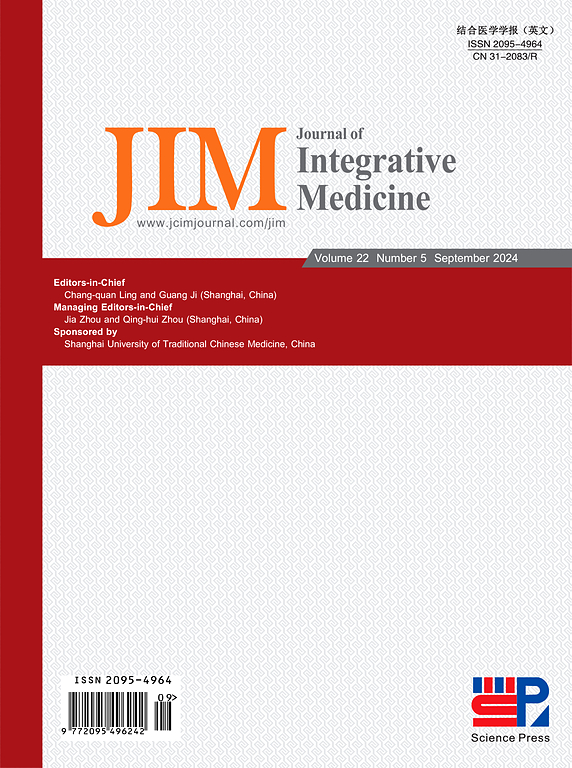Electroacupuncture activates AMPKα1 to improve learning and memory in the APP/PS1 mouse model of early Alzheimer’s disease by regulating hippocampal mitochondrial dynamics
IF 4
2区 医学
Q1 INTEGRATIVE & COMPLEMENTARY MEDICINE
引用次数: 0
Abstract
Objective
Studies have shown that electroacupuncture (EA) can alleviate cognitive impairments from Alzheimer’s disease (AD) by regulating the expression of adenosine monophosphate-activated protein kinase (AMPK), but the specific mechanism involved remains to be elucidated. Therefore, this study explores the potential mechanism by which EA improves cognitive function from the perspective of mitochondrial dynamics.
Methods
The four-month-old transgenic mice with amyloid precursor protein (APP)/presenilin 1 (PS1) and AMPKα1-subunit conditional knockout (AMPKα1-cKO) were used for experiments. To evaluate the effects of EA treatment on cognitive function, the T-maze and Morris water maze were used. In addition, chemical exchange saturation transfer, thioflavin staining, transmission electron microscopy, mitochondrial membrane potential, and Western blotting were used to examine the potential mechanisms underlying the effects of EA on APP/PS1 mice.
Results
Both APP/PS1 mice and AMPKα1-cKO mice exhibited dysfunction in mitochondrial dynamics accompanied by learning and memory impairment. Inactivation of the AMPK/peroxisome proliferator-activated receptor-γ coactivator-1α (PGC-1α) pathway increased pathological amyloid-β (Aβ) deposition and aggravated the dysfunction in mitochondrial dynamics. In addition, EA rescued learning and memory deficits in APP/PS1 mice by activating the AMPK/PGC-1α pathway, specifically by reducing pathological Aβ deposition, normalizing energy metabolism, protecting the structure and function of mitochondria, increasing the levels of mitochondrial fusion proteins, and downregulating the expression of fission proteins. However, the therapeutic effect of EA on cognition in APP/PS1 mice was hindered by AMPKα1 knockout.
Conclusion
The regulation of hippocampal mitochondrial dynamics and reduction in Aβ deposition via the AMPK/PGC-1α pathway are critical for the ability of EA to ameliorate cognitive impairment in APP/PS1 mice.
Please cite this article as: Jia WW, Lin HW, Yang MG, Dai YL, Ding YY, Xu WS, Wang SN, Cao YJ, Liang SX, Wang ZF, Chen C, Liu WL. Electroacupuncture activates AMPKα1 to improve learning and memory in the APP/PS1 mouse model of early Alzheimer’s disease by regulating hippocampal mitochondrial dynamics. J Integr Med. 2024; 22(5): 588–599.
电针通过调节海马线粒体动力学激活AMPKα1,从而改善早期阿尔茨海默病APP/PS1小鼠模型的学习和记忆。
研究目的研究表明,电针(EA)可通过调节单磷酸腺苷激活蛋白激酶(AMPK)的表达,缓解阿尔茨海默病(AD)引起的认知功能障碍,但其具体机制仍有待阐明。因此,本研究从线粒体动力学的角度探讨了EA改善认知功能的潜在机制:实验采用四个月大的淀粉样前体蛋白(APP)/淀粉样前体蛋白1(PS1)和AMPKα1亚基条件性敲除(AMPKα1-cKO)转基因小鼠。为了评估EA处理对认知功能的影响,实验采用了T迷宫和莫里斯水迷宫。此外,还采用了化学交换饱和转移、硫黄素染色、透射电子显微镜、线粒体膜电位和Western印迹等方法来研究EA对APP/PS1小鼠影响的潜在机制:结果:APP/PS1小鼠和AMPKα1-cKO小鼠均表现出线粒体动力学功能障碍,并伴有学习和记忆障碍。AMPK/过氧化物酶体增殖激活受体-γ辅助激活剂-1α(PGC-1α)通路的失活增加了病理性淀粉样蛋白-β(Aβ)沉积,加剧了线粒体动力学功能障碍。此外,EA通过激活AMPK/PGC-1α通路,特别是通过减少病理性Aβ沉积、使能量代谢正常化、保护线粒体的结构和功能、提高线粒体融合蛋白的水平以及下调裂变蛋白的表达,来挽救APP/PS1小鼠的学习和记忆缺陷。然而,AMPKα1基因敲除阻碍了EA对APP/PS1小鼠认知能力的治疗效果:结论:通过AMPK/PGC-1α途径调节海马线粒体动力学和减少Aβ沉积是EA改善APP/PS1小鼠认知障碍的关键。本文引用如前Jia WW, Lin HW, Yang MG, Dai YL, Ding YY, Xu WS, Wang SN, Cao YJ, Liang SX, Wang ZF, Chen C, Liu WL.电针通过调节海马线粒体动力学激活 AMPKα1 以改善早期阿尔茨海默病 APP/PS1 小鼠模型的学习记忆能力J Integr Med.2024; Epub ahead of print.
本文章由计算机程序翻译,如有差异,请以英文原文为准。
求助全文
约1分钟内获得全文
求助全文
来源期刊

Journal of Integrative Medicine-Jim
Medicine-Complementary and Alternative Medicine
CiteScore
9.20
自引率
4.20%
发文量
3319
期刊介绍:
The predecessor of JIM is the Journal of Chinese Integrative Medicine (Zhong Xi Yi Jie He Xue Bao). With this new, English-language publication, we are committed to make JIM an international platform for publishing high-quality papers on complementary and alternative medicine (CAM) and an open forum in which the different professions and international scholarly communities can exchange views, share research and their clinical experience, discuss CAM education, and confer about issues and problems in our various disciplines and in CAM as a whole in order to promote integrative medicine.
JIM is indexed/abstracted in: MEDLINE/PubMed, ScienceDirect, Emerging Sources Citation Index (ESCI), Scopus, Embase, Chemical Abstracts (CA), CAB Abstracts, EBSCO, WPRIM, JST China, Chinese Science Citation Database (CSCD), and China National Knowledge Infrastructure (CNKI).
JIM Editorial Office uses ThomsonReuters ScholarOne Manuscripts as submitting and review system (submission link: http://mc03.manuscriptcentral.com/jcim-en).
JIM is published bimonthly. Manuscripts submitted to JIM should be written in English. Article types include but are not limited to randomized controlled and pragmatic trials, translational and patient-centered effectiveness outcome studies, case series and reports, clinical trial protocols, preclinical and basic science studies, systematic reviews and meta-analyses, papers on methodology and CAM history or education, conference proceedings, editorials, commentaries, short communications, book reviews, and letters to the editor.
Our purpose is to publish a prestigious international journal for studies in integrative medicine. To achieve this aim, we seek to publish high-quality papers on any aspects of integrative medicine, such as acupuncture and traditional Chinese medicine, Ayurveda medicine, herbal medicine, homeopathy, nutrition, chiropractic, mind-body medicine, taichi, qigong, meditation, and any other modalities of CAM; our commitment to international scope ensures that research and progress from all regions of the world are widely covered. These ensure that articles published in JIM have the maximum exposure to the international scholarly community.
JIM can help its authors let their papers reach the widest possible range of readers, and let all those who share an interest in their research field be concerned with their study.
 求助内容:
求助内容: 应助结果提醒方式:
应助结果提醒方式:


